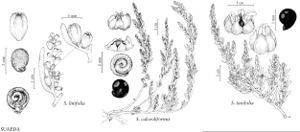Suaeda taxifolia
Publ. Field Mus., Bot. Ser. 8: 10. 1930.
Shrubs or subshrubs, 1–15 dm. Stems spreading or erect, woody stems dull gray-brown, herbaceous stems light green or red, glaucous, usually puberulent to shortly villous, sometimes glabrous, leaf-scars on woody stems knobby; branches spreading. Leaves ascending to widely spreading, subsessile; petiole ± 1 mm; blade blue-green, yellow-green, or red, glaucous, lanceolate to narrowly ovate, subcylindric or semiterete, 5–30 × 0.6–2 mm, apex acute to acuminate, usually puberulent to shortly villous, sometimes glabrous. Glomes distributed throughout plant on branches, 1–3-flowered; branches 2–4 mm diam.; bracts similar in shape and size to leaves. Flowers bisexual or lateral pistillate; perianth 1–3 mm diam.; perianth segments proximally connate, usually pubescent; ovary ± vase-shaped with distal necklike extension; stigmas 3–4. Seeds horizontal or vertical, 1–2 mm; seed-coat black or brown.
Phenology: Flowering nearly year-round.
Habitat: Coastal bluffs, margins of salt marshes
Elevation: 0-20 m
Distribution

Calif., Mexico (Baja California)
Discussion
Suaeda taxifolia is a highly variable species with many habit, leaf, and pubescence phenotypes, which have resulted in the naming of several variants that appear to reflect local or regional habitat conditions. P. A. Munz (1958) considered this species to be part of S. californica, and referred the longer-leaved, larger-flowered, pubescent plants of coastal southern California to S. californica var. taxifolia; and the shorter-leaved, smaller-flowered, and densely pubescent plants to var. pubescens. However, S. californica is a plant largely of intertidal estuarine shores and marshes and occurs only in central California, whereas S. taxifolia occurs largely on bluffs and occasionally on margins of estuaries in southern California and Baja California in Mexico (W. R. Ferren Jr. 1993). Throughout its range, S. taxifolia varies considerably in leaf shape and density of pubescence.
Selected References
None.
Lower Taxa
"dark-green" is not a number.
